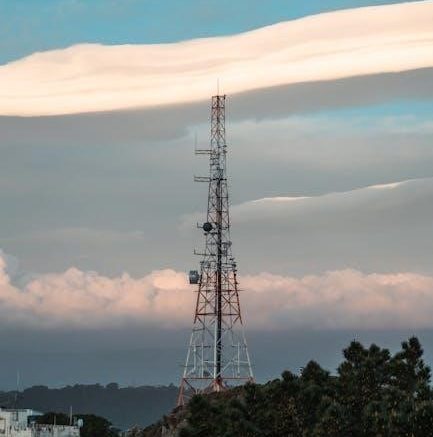Hills TV antennas provide a reliable way to access free over-the-air channels‚ offering both indoor and outdoor options designed to suit various locations and signal needs.
Whether you’re in urban or suburban areas‚ Hills antennas are built to optimize signal strength and ensure high-quality TV reception‚ helping you cut the cord from cable.
With options for amplified and non-amplified models‚ Hills antennas cater to different distances from broadcast towers and varying signal conditions‚ ensuring clear and consistent viewing experiences.
Using tools like FCC maps to determine broadcast tower locations‚ users can select the ideal Hills antenna for their setup‚ ensuring optimal performance and channel availability.
1.1 What Are Hills TV Antennas?
Hills TV antennas are specialized devices designed to capture over-the-air broadcast signals‚ providing access to free local TV channels. They come in various types‚ including indoor and outdoor models‚ to suit different locations and signal needs. These antennas are engineered to optimize signal strength and quality‚ ensuring clear and consistent TV reception. Whether you’re in an urban or suburban area‚ Hills antennas offer solutions tailored to your environment. They are compatible with both standard and advanced broadcast technologies‚ making them a reliable choice for cord-cutters. With options for amplified and non-amplified versions‚ Hills antennas cater to users at varying distances from broadcast towers‚ ensuring optimal performance and channel availability.
1.2 Benefits of Using Hills TV Antennas
Hills TV antennas offer numerous benefits‚ including access to free over-the-air channels‚ eliminating monthly subscription fees. They provide high-definition TV reception without compression‚ ensuring superior picture quality. With compatibility for 4K and ATSC 3.0‚ Hills antennas future-proof your viewing experience. Their durability and weather-resistant designs make them ideal for outdoor use‚ while indoor models blend seamlessly with home decor. Hills antennas are eco-friendly‚ reducing reliance on cable and satellite services. They also serve as a reliable backup during internet or cable outages. Whether in urban or rural areas‚ Hills antennas deliver consistent signal strength‚ making them a cost-effective and practical solution for cord-cutters seeking premium TV entertainment.
1.3 Brief History of Hills TV Antennas
Hills TV antennas have a long-standing reputation as pioneers in over-the-air television solutions. Founded with a commitment to innovation‚ Hills has been perfecting antenna technology for decades. The company began by addressing the need for reliable signal reception in diverse terrains and distances from broadcast towers. Over the years‚ Hills expanded its product line to meet evolving TV standards‚ from analog to digital and now 4K and ATSC 3.0 compatibility. Known for durability and performance‚ Hills antennas have become a trusted choice for cord-cutters worldwide. Their history reflects a dedication to adapting technology to enhance viewer experiences‚ ensuring high-quality entertainment remains accessible to everyone. This legacy continues to drive Hills as a leader in the TV antenna industry.

Understanding TV Antenna Basics
TV antennas capture over-the-air signals‚ converting them into channels for free viewing. Direction‚ location‚ and signal strength are key factors affecting reception quality and channel availability.
2.1 Types of TV Antennas
TV antennas come in various types‚ each designed for specific needs. Indoor antennas are compact and suitable for urban areas‚ while outdoor antennas offer stronger signals for rural or obstructed locations.
Directional antennas focus on signals from a specific direction‚ ideal for areas with distant broadcast towers‚ whereas omnidirectional antennas capture signals from all directions‚ providing broader coverage.
Amplified antennas boost weak signals‚ enhancing reception in areas with obstacles or greater distances from towers‚ while non-amplified antennas suffice for closer‚ stronger signals.
Choosing the right type depends on location‚ signal strength‚ and channel availability‚ ensuring optimal performance for a seamless viewing experience.
2.2 How TV Antennas Work
TV antennas function by capturing broadcast signals transmitted from towers‚ converting them into a format your television can display. These signals are radio waves at specific frequencies.
The antenna’s design determines its ability to receive signals effectively‚ with factors like placement and orientation impacting performance. Moving the antenna closer to a window or higher locations often improves reception.
Once connected‚ the TV scans for available channels‚ saving those with strong enough signals. This process ensures access to free over-the-air content without cable or satellite subscriptions.
Some antennas include amplifiers to boost weak signals‚ enhancing reception in areas with obstacles or greater distances from broadcast towers‚ ensuring clearer and more reliable viewing experiences.
2.3 Key Features to Look for in a TV Antenna
When selecting a TV antenna‚ consider factors like frequency range (UHF/VHF)‚ gain‚ and directional vs. omnidirectional capabilities to ensure optimal signal capture.
Amplifiers can boost weak signals‚ especially in areas with obstacles or greater distances from towers‚ ensuring stronger and more stable reception.
Look for antennas compatible with 4K and ATSC 3.0 standards for future-proofing and enhanced picture quality. Durability and weather resistance are crucial for outdoor models.
Smart technology integration‚ such as app control or signal strength indicators‚ can simplify setup and optimization. Ensure the antenna is easy to install and position for best results.
Matching the antenna’s features to your specific location and channel availability ensures the best viewing experience and long-term satisfaction;

Factors to Consider When Selecting a Hills TV Antenna
Assess your location’s proximity to broadcast towers‚ terrain challenges‚ and signal strength to determine the best Hills TV antenna for reliable reception and optimal performance.
Consider whether an amplifier is needed for weaker signals and consider indoor or outdoor placement based on your environment and channel availability.
3.1 Distance from Broadcast Towers
Your distance from broadcast towers significantly impacts the performance of your Hills TV antenna. Use the FCC DTV Reception Maps to determine your proximity to local towers.
If you live within 30 miles of the towers‚ an indoor antenna may suffice. For longer distances‚ consider an outdoor antenna for stronger signal capture.
In suburban or urban areas‚ signals are generally stronger‚ but rural or mountainous regions may require amplified antennas to overcome signal degradation.
Always check the recommended antenna type based on your location to ensure optimal channel reception and viewing experience.
3.2 Terrain and Obstructions
Terrain and obstructions play a crucial role in determining the effectiveness of your Hills TV antenna. Hills‚ buildings‚ and trees can block or weaken signals‚ reducing reception quality.
Physical obstructions like metal structures or dense foliage can reflect or absorb signals‚ leading to poor channel clarity. Moving the antenna closer to a window or elevating it can help mitigate these issues.
In areas with significant terrain challenges‚ an outdoor antenna may be necessary to bypass obstructions and achieve a clearer line of sight to broadcast towers.
Always assess your surroundings and test different antenna positions to find the optimal setup for uninterrupted viewing.
3.3 Signal Strength and Quality
Signal strength and quality are critical factors in ensuring optimal performance from your Hills TV antenna. A strong signal guarantees clear reception‚ while poor quality can lead to pixelation or channel loss.
Factors such as distance from broadcast towers‚ terrain‚ and obstructions significantly impact signal strength. Hills antennas are designed to capture signals effectively‚ but physical barriers like buildings or trees can weaken reception.
To enhance signal quality‚ consider using an amplifier or choosing an antenna with higher gain. Regularly checking signal strength and adjusting the antenna position can also improve performance.
Optimizing your setup ensures access to a wide range of channels with minimal interference‚ providing a seamless viewing experience.

Choosing the Right Type of Hills TV Antenna
Selecting the right Hills TV antenna depends on your location‚ signal strength‚ and viewing preferences. Indoor‚ outdoor‚ amplified‚ and directional options cater to different needs for optimal reception.
4.1 Indoor vs. Outdoor Antennas
Choosing between indoor and outdoor Hills TV antennas depends on your location and signal needs. Indoor antennas are ideal for urban and suburban areas‚ offering compact designs that easily fit inside your home. They are perfect for locations within 30 miles of broadcast towers and provide reliable reception for local channels. Outdoor antennas‚ on the other hand‚ are designed for longer distances and challenging terrains‚ such as rural areas or regions with obstructions like hills or trees. Outdoor models often come with higher gain and better signal strength‚ making them suitable for areas farther from broadcast towers. Both options ensure high-quality reception‚ but outdoor antennas typically require professional installation and offer superior performance in difficult conditions.
4.2 Amplified vs. Non-Amplified Antennas
When selecting a Hills TV antenna‚ deciding between amplified and non-amplified models is crucial. Amplified antennas include a built-in booster to strengthen weak signals‚ ideal for areas far from broadcast towers or with obstacles like hills or buildings. They help maintain stable reception‚ reducing pixelation and channel loss. Non-amplified antennas‚ however‚ are simpler and cost-effective‚ suitable for strong signal areas. They lack the amplifier‚ making them easier to install and more energy-efficient. Choose amplified antennas for challenging conditions and non-amplified for reliable performance in strong signal zones. Assessing your location and signal strength will guide the best choice for optimal viewing experience.
4.3 Directional vs. Omnidirectional Antennas
Choosing between directional and omnidirectional antennas depends on your broadcast tower setup. Directional antennas are designed to focus on signals from specific directions‚ enhancing reception from distant or weak towers while reducing interference. They are ideal for rural or suburban areas with towers clustered in one direction. Omnidirectional antennas‚ however‚ capture signals from all directions‚ making them perfect for urban or suburban locations with multiple broadcast towers surrounding you. Directional antennas often require precise aiming toward the towers‚ while omnidirectional models offer flexibility and ease of use. Assessing your tower locations and signal strength will help determine which type best suits your needs for optimal TV reception.

Installation and Optimization Tips
Locate broadcast towers using FCC maps‚ position your antenna near a window‚ and adjust for optimal signal strength. Regular checks ensure consistent reception quality and minimize interference.
5.1 Locating Broadcast Towers Using FCC Maps
To determine the best placement for your Hills TV antenna‚ use the Federal Communications Commission (FCC) DTV Reception Maps tool. Visit the FCC website and enter your address to view a detailed map of local broadcast towers. This tool provides information on the direction‚ distance‚ and signal strength of nearby towers‚ helping you identify the optimal antenna position. Towers located within a 30-mile radius typically offer the strongest signals. The map also highlights areas with strong (green)‚ moderate (yellow)‚ and weak (red) reception. By understanding the tower locations‚ you can aim your antenna accordingly and maximize signal quality. This step ensures you select the right antenna type and placement for reliable over-the-air TV viewing;
5.2 Finding the Best Location for Your Antenna
Positioning your Hills TV antenna correctly is crucial for optimal signal reception. Start by placing the antenna near a window or elevated area to minimize obstructions like walls or furniture. Avoid areas with metal objects‚ as they can cause interference. For indoor antennas‚ try moving the antenna closer to a window facing the direction of the broadcast towers identified via FCC maps. Outdoor antennas should be mounted as high as possible to reduce signal blockage from terrain or buildings. Experiment with placement‚ as even small adjustments can improve reception. Use the TV’s channel scan feature to test signal strength and adjust the antenna accordingly. Ensure the antenna is securely fastened to avoid movement‚ which can disrupt signal quality. Proper placement ensures reliable access to free over-the-air channels.
5.3 Adjusting Antenna Position for Optimal Signal
Adjusting your Hills TV antenna’s position is key to achieving the best signal quality. Start by testing different locations‚ such as moving the antenna closer to a window or higher up on a wall. Use the TV’s built-in channel scan feature to gauge signal strength as you reposition the antenna. Experiment with directional adjustments to align the antenna with nearby broadcast towers. If using an indoor antenna‚ try placing it near a window facing the direction of the towers. For outdoor antennas‚ elevation is critical—mounting it higher can reduce interference from obstacles. Fine-tune the antenna’s angle to maximize signal strength‚ and ensure it’s securely fastened to avoid movement. Small adjustments can significantly improve reception quality‚ ensuring access to more channels with clearer playback.

Troubleshooting Common Issues
Troubleshooting Hills TV antenna issues involves checking signal strength‚ ensuring secure connections‚ and repositioning to avoid obstructions. Moving the antenna away from devices can reduce interference and improve reception.
6.1 Dealing with Poor Reception
Poor reception with Hills TV antennas can often be resolved by adjusting the antenna’s position or direction. Use FCC maps to identify broadcast tower locations and ensure the antenna is pointing correctly. Moving the antenna closer to a window or higher up in the room can improve signal strength. Check for loose connections and ensure all cables are securely attached. If living in areas with weak signals‚ consider using an amplified antenna to boost reception. Avoid placing the antenna near metal objects or electronic devices‚ as they can cause interference. Regularly rescan for channels after adjustments to ensure optimal performance and access to all available stations.
6.2 Minimizing Interference from Other Devices
Minimizing interference from other devices is crucial for optimal Hills TV antenna performance. Common sources of interference include Wi-Fi routers‚ smartphones‚ and other electronic devices. To reduce interference‚ place the antenna away from these devices and ensure it is positioned in an area with minimal obstructions. Use high-quality coaxial cables to minimize signal loss and interference. Additionally‚ avoid placing the antenna near metal objects or walls‚ as they can reflect or block signals. If interference persists‚ consider using a filter or adjusting the antenna’s direction to isolate the signal. Regularly check for software updates on connected devices and ensure the antenna is correctly grounded to reduce electromagnetic interference.

Cost and Value Considerations
Hills TV antennas offer affordable options for accessing free channels. Budgeting is key‚ and comparing features ensures value. Assess long-term savings by choosing the right model.
7.1 Budgeting for Your Hills TV Antenna
Budgeting for a Hills TV antenna involves considering your viewing needs and location. Indoor antennas are cost-effective for urban areas‚ while outdoor models suit rural settings.
Set a budget based on the type of antenna required. Basic indoor antennas are affordable‚ while amplified or directional models may cost more.
Factor in installation costs if professional help is needed. Use FCC maps to determine the necessary antenna type‚ ensuring you don’t overspend on unnecessary features.
Hills antennas are generally priced affordably‚ offering long-term savings by eliminating cable fees. Consider reading reviews to find the best value within your budget.
Compare prices and features to ensure you’re getting the best deal. Remember‚ a higher price doesn’t always mean better performance for your specific needs.
7.2 Comparing Prices and Features
When comparing Hills TV antennas‚ consider price‚ range‚ and features. Indoor antennas are typically cheaper‚ starting from $20-$50‚ while outdoor models range from $50-$150.
Amplified antennas cost more but improve signal strength in weak areas. Directional antennas are pricier than omnidirectional ones but offer better performance for distant towers.
Check if the antenna supports 4K and ATSC 3.0 for future-ready viewing. Smart features like app control may add to the cost but enhance convenience.
Compare prices across retailers and consider bundle deals. Higher prices don’t always mean better performance; match the antenna’s specs to your needs.
Read reviews to ensure the antenna’s features justify its price. Focus on what you need for your location and viewing habits to make an informed decision.
7.3 Assessing Long-Term Value
Assessing the long-term value of Hills TV antennas involves evaluating durability‚ performance‚ and cost-effectiveness over time. A higher initial investment may yield savings through reliable service and fewer replacements.
Look for antennas with robust build quality and weather-resistant materials for outdoor use. Ensure compatibility with future technologies like 4K and ATSC 3.0 for longevity.
Consider maintenance needs‚ such as regular cleaning and signal checks‚ to extend lifespan. A good warranty can also enhance long-term value by protecting your investment.
Evaluate how well the antenna performs in your area long-term‚ factoring in potential changes in broadcast signals or local obstructions.
By focusing on these factors‚ you can choose a Hills TV antenna that offers consistent performance and lasting satisfaction‚ making it a wise long-term investment.

Additional Features to Consider
Explore additional features like built-in amplifiers for stronger signals‚ compatibility with 4K and ATSC 3.0 for future-ready viewing‚ and smart technology for enhanced channel navigation.
8.1 Built-In Amplifiers for Better Signal
Built-in amplifiers are a valuable feature in Hills TV antennas‚ designed to enhance signal strength and quality. By boosting weak signals‚ they improve reception in areas with obstructions or longer distances from broadcast towers. Amplifiers help reduce interference‚ ensuring clearer and more stable channels. They are particularly useful in suburban or rural settings where signal strength may be weaker; However‚ it’s important to avoid over-amplifying‚ as this can degrade signal quality. When selecting an antenna with an amplifier‚ consider your specific needs and location to maximize performance. This feature ensures you enjoy a better viewing experience with minimal interruptions‚ making it a worthwhile investment for reliable over-the-air TV watching.
8.2 Compatibility with 4K and ATSC 3.0
Hills TV antennas are designed to support the latest advancements in broadcast technology‚ including 4K resolution and ATSC 3.0 standards. This compatibility ensures that users can enjoy ultra-high-definition content with enhanced picture and sound quality. ATSC 3.0 also offers improved features like HDR‚ wider color gamuts‚ and immersive audio‚ providing a superior viewing experience. By supporting these cutting-edge technologies‚ Hills antennas future-proof your setup‚ allowing you to take full advantage of next-generation broadcasts as they become widely available. This ensures that your antenna remains a reliable and high-performance solution for accessing free over-the-air content‚ even as TV technology continues to evolve.
8.3 Smart Technology Integration
Modern Hills TV antennas often feature smart technology integration‚ enhancing user experience through innovative features. These antennas can connect to smartphones or tablets via dedicated apps‚ allowing users to control settings‚ scan for channels‚ and optimize signal strength remotely. Some models offer voice control compatibility with popular smart home systems‚ enabling hands-free adjustments. Additionally‚ built-in diagnostic tools provide real-time signal strength analysis‚ helping users position the antenna for optimal reception. This seamless integration with smart devices ensures a more convenient and personalized viewing experience‚ making it easier than ever to enjoy free over-the-air content with minimal effort and maximum satisfaction.

Maintenance and Upkeep
Regular maintenance ensures optimal performance of Hills TV antennas; Clean the antenna periodically to remove dust and debris‚ and check for loose connections to maintain signal strength. Always use a soft cloth to avoid scratching the surface. Inspect the antenna for damage and replace any worn-out parts promptly. Additionally‚ perform regular signal strength checks using built-in diagnostic tools or apps to ensure consistent reception. For specific care instructions‚ refer to the user manual provided with your Hills TV antenna. Proper upkeep ensures long-lasting performance and reliable access to your favorite channels. Regular checks and minor adjustments can prevent signal issues and enhance overall viewing quality.
9.1 Cleaning Your Hills TV Antenna
To maintain optimal performance‚ regularly clean your Hills TV antenna. Start by turning off and unplugging your TV and devices to ensure safety. Use a soft‚ slightly damp microfiber cloth to gently wipe down the antenna‚ avoiding harsh chemicals or abrasive materials that could damage the surface. For intricate parts‚ such as the antenna elements‚ use a clean cotton swab to remove dust and debris. Inspect and clean connectors and coaxial cables for dirt or corrosion‚ using a vinegar-dampened cloth if necessary‚ but avoid getting liquid inside components. Allow all parts to dry completely before reconnecting to prevent moisture damage. Regular cleaning‚ especially in areas prone to pollen or after storms‚ helps maintain signal quality. Schedule cleanings every few months and consider using a ladder or brush for outdoor antennas. Avoid using specialized cleaning products to prevent residue buildup. By following these steps‚ you can ensure your antenna remains in optimal condition‚ providing clear and consistent reception.

9.2 Regular Signal Strength Checks
Regular signal strength checks are essential to ensure your Hills TV antenna is performing optimally. Start by accessing your TV’s built-in signal strength meter through the settings menu. This tool provides a visual representation of signal quality‚ helping you identify weak or unstable channels. Perform checks after installing your antenna‚ repositioning it‚ or experiencing poor reception. For outdoor antennas‚ inspect for physical damage or obstructions like tree branches or debris. Use a signal strength app or meter for more detailed analysis. Check signals during different times of the day‚ as interference can vary. If signal strength drops‚ consider repositioning the antenna or using an amplifier. Regular checks ensure consistent‚ high-quality TV viewing and help address issues before they become problematic. Schedule these checks every few months‚ especially after storms or seasonal changes.
